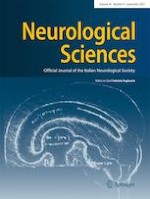Erschienen in:

17.06.2022 | Original Article
Anti-seizure medication treatment and outcomes in acute ischemic stroke patients undergoing continuous EEG monitoring
verfasst von:
Paula R. Sanches, Mohammad Tabaeizadeh, Lidia M. V. R. Moura, Eric S. Rosenthal, Luis Otavio Caboclo, John Hsu, Elisabetta Patorno, M. Brandon Westover, Sahar F. Zafar
Erschienen in:
Neurological Sciences
|
Ausgabe 9/2022
Einloggen, um Zugang zu erhalten
Abstract
Objectives
To
determine the association of anti-seizure medication (ASM) treatment with outcomes in acute ischemic stroke (AIS) patients undergoing continuous electroencephalography (cEEG).
Methods
Retrospective analysis of AIS patients admitted between 2012 and 2019. The following are the inclusion criteria: age ≥ 18 years and ≥ 16 h of cEEG within the first 7 days of admission. ASM treatment exposure was defined as > 48 h of treatment after the first 24 h of cEEG. The primary outcome measure was 90-day mortality, and the secondary outcome was 90-day functional recovery (Modified Ranking Scale 0–3). Propensity scores were used to adjust for baseline covariates and presence of epileptiform abnormalities (seizures, periodic and rhythmic patterns).
Results
One hundred thirteen patients met the inclusion criteria; 39 (34.5%) were exposed to ASM. ASM treatment was not associated with 90-day mortality (propensity adjusted HR 1.0 [0.31–3.27], p = 0.999) or functional outcomes (adjusted HR 0.99 [0.32–3.02], p = 0.989), compared to no treatment.
Conclusions
In our study, ASM treatment in AIS patients with cEEG abnormalities was not significantly associated with a change in 90-day mortality and functional recovery. Larger comparative effectiveness studies are indicated to identify which acute ischemic stroke patients with cEEG abnormalities benefit most from ASM treatment.